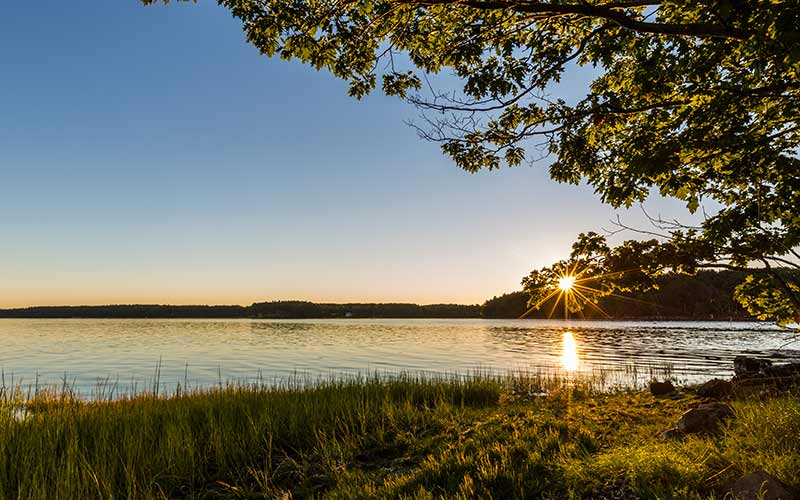
Great Bay is one of the vital bodies of water that needs support after a summer of intense rain. Photo: CLF
“When it rains, it pours” seems an apt adage for the summer of 2023. While there were a few stretches of sunny weather, for many it was a season of rained-out outings, postponed picnics, and soggy spirits.
The data bears out just how damp it was this summer. The period from June through August ranks as the wettest in New Hampshire’s history, with more than 21 inches of rain – nearly double the mean over the past 100 years – taking a toll on the rivers, bays, beaches, and economy in coastal New Hampshire’s Great Bay region.
Excess rain hurts the ecosystem and the economy
One industry hit hard by the record rain is the area’s commercial oyster farmers who, last year, harvested nearly one million oysters from Little Bay. Laura Brown of Fox Point Oysters explains that “when there’s more than 1½ inches of rain in a 24-hour period, the New Hampshire Shellfish Warden closes the oyster beds to harvesting to avoid any risk of exposing people to bacteria and pollutants that wash into the bay from untreated stormwater runoff.” These closures can last several days until water quality testing shows the water is clean. During the peak harvest months of summer, they dealt major financial blows.
It was also a very tough season for eelgrass, another critical species in the Great Bay estuary. These underwater meadows of grasses – which normally provide habitat for fish, fill water with life-giving oxygen, and hold sediment in place with thick roots – really struggled. For much of the summer, the waters of the Great Bay estuary were stirred up from all the stormwater loaded with organic matter and sediment.
Kalle Matso, director of the Piscataqua Region Estuaries Partnership, says, “The eelgrass beds down at the Portsmouth Harbor end of the estuary did fine, but up in Great Bay, it’s a sad story. For much of the summer the water was almost chocolatey brown – without clear water and sunlight, much of the eelgrass just couldn’t survive.”
The heavy rains also took a toll on some wildlife species. Take the pair of ospreys that nest every year at the Great Bay Reserve in Greenland. While the parents hatched three chicks, in full view of a live-cam with a dedicated fan base, not one survived. Kelle Loughlin, education director at the Great Bay Reserve, explained that “because the water was so turbid, the adult osprey likely could not spot fish nearby to feed their chicks. What should have been a time of tending to the chicks and nest turned into a desperate hunt for food. It was tough to watch them struggle and see one chick after another lose the battle.”
Communities take action to protect clean water
But even as the summer’s heavy rains took a toll on plants and critters, it seemed to mobilize many humans to speak out for clean water. In Portsmouth, there was a groundswell of concern about the frequency with which the city’s combined sewers overflowed into the Piscataqua River and South Mill Pond. While the City has been working hard at the costly job of separating the stormwater pipes from the sewer system, there’s still more work to do to prevent the pollution from combined sewers when it rains heavily over a short time.
Across the Piscataqua River in Kittery, concerned residents formed a group called Save Kittery Waters to spread the word about how people can reduce fertilizer and pesticide use, protect plants along the edge of wetlands and creeks, and maintain septic systems. Each of these actions is critical for reducing harmful nitrogen pollution into Great Bay. The residents launched the Creek Smart Campaign at a well-attended public event in July and held another community event at the town library in October. A large Creek Smart banner encouraging people to take a pledge to “protect Kittery’s waters” now hangs across the main road through Kittery. In a bold move for public awareness, the town’s street sweeper sports a Creek Smart sign on its sides urging residents to be better stewards of local waterways.
Throughout the season, I collaborated with conservation organizations on a series of Wednesday Watershed Walks that have brought dozens of people together to explore beautiful and important protected lands along the rivers and coast of the Great Bay region. The series began in the headwaters of the Salmon Falls River with the Acton-Wakefield Watersheds Alliance and has continued at properties owned by Southeast Land Trust of New Hampshire, The Nature Conservancy, the Forest Society, and more.
Another exciting program that got underway this fall is the Great Bay Changemaker’s Bootcamp. In partnership with The Forward Foundation, a collaborative of organizations around the Great Bay region launched a workshop series focused on the Cocheco River. The goal is to help people in Dover, Rochester, and Farmington become more effective advocates for clean water. With new skills and a better understanding of how land use decisions are made in our communities, residents can push for policies and investments that protect, rather than pollute, our environment.
Indeed, the summer of 2023 was a wet one. But it also saw an outpouring of concern and engagement. With more people stepping up, speaking out, and connecting to our waterways and to each other, we’ll continue leaning into the work of protecting the beautiful places we call home.



